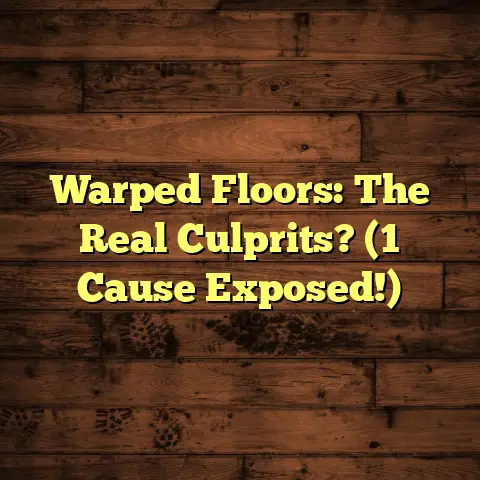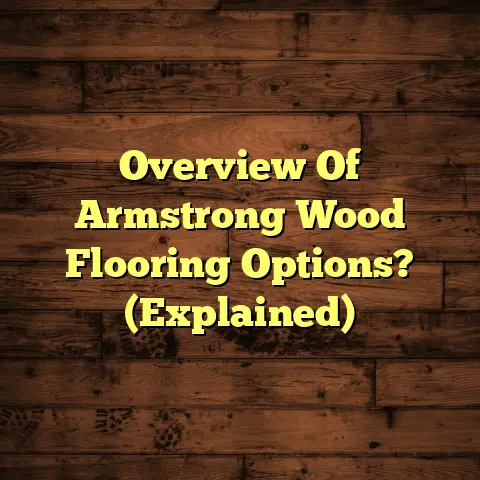LVP vs Laminate: Better? (7 Point Check!)
I’m excited to dive into a topic that’s close to my heart (and my business): flooring!
If you’re anything like me, you’re always looking for ways to improve your home without breaking the bank.
Flooring is a big part of that, and choosing the right material can make a huge difference, not just in how your home looks, but also in your long-term savings.
Why Flooring Matters (More Than You Think)
We’re seeing a massive surge in home renovations these days. Everyone wants to create a space that’s both beautiful and functional.
And let’s be honest, the right flooring can completely transform a room.
But it’s not just about aesthetics. It’s about making smart financial decisions that will pay off in the long run.
That’s where Luxury Vinyl Plank (LVP) and laminate flooring come into play.
They’ve both become incredibly popular because they offer a great balance of affordability and durability.
But which one is the better choice for long-term savings? That’s what we’re going to unpack in this article.
The 7-Point Check: Your Guide to Flooring Freedom
I’ve put together a comprehensive comparison that looks at seven key factors:
- Initial cost
- Installation costs
- Durability and longevity
- Maintenance and cleaning
- Aesthetic appeal and variety
- Environmental impact
- Resale value
By the end of this article, you’ll have a clear understanding of the pros and cons of each flooring option, so you can make the best decision for your home and your wallet.
Ready to get started? Let’s jump in!
Point 1: Initial Cost – What’s the Damage Up Front?
Alright, let’s talk money! The initial cost is often the first thing people consider when choosing flooring.
And for good reason!
It’s important to have a realistic understanding of what you’re going to spend right off the bat.
LVP vs. Laminate: The Price Breakdown
Generally speaking, LVP and laminate are pretty comparable in terms of initial cost.
However, there can be some subtle differences.
- LVP: You can typically find LVP ranging from around $2 to $7 per square foot.
- Laminate: Laminate usually falls in the $1 to $5 per square foot range.
Source: Home Depot, Lowe’s (2024)
Now, before you jump to conclusions, remember that these are just averages.
The actual price can vary depending on several factors:
- Brand: Just like with any product, some brands are more expensive than others.
- Thickness: Thicker planks generally cost more, but they also tend to be more durable.
- Style: Certain styles, like those that mimic exotic hardwoods, can also command a higher price.
Budget-Friendly Finds and High-End Splurges
Looking for a bargain? You can definitely find budget-friendly options for both LVP and laminate.
These might be thinner planks or simpler styles, but they can still look great and get the job done.
On the other hand, if you’re willing to splurge a little, you can find high-end LVP and laminate that offer incredible realism and durability.
These options often feature thicker wear layers, more detailed textures, and enhanced water resistance.
The Bottom Line: Initial Cost and Long-Term Savings
So, how does the initial cost impact long-term savings?
Well, it’s pretty straightforward: the less you spend upfront, the more money you save in the short term.
However, it’s crucial to remember that the initial cost is just one piece of the puzzle.
A cheaper flooring option might seem appealing at first, but if it doesn’t last as long or requires more maintenance, you could end up spending more money in the long run.
I always tell my clients to consider the total cost of ownership, not just the initial price tag.
Point 2: Installation Costs – DIY or Call a Pro?
Okay, you’ve picked out your flooring, now it’s time to get it installed! This is where things can get a little tricky, especially when it comes to costs.
DIY vs. Professional Installation: The Great Debate
One of the biggest factors affecting installation costs is whether you decide to tackle the project yourself or hire a professional.
- LVP: LVP is generally considered to be more DIY-friendly than laminate. Many LVP products feature a simple click-lock system that makes installation a breeze.
- Laminate: Laminate can also be installed DIY, but it often requires a bit more skill and precision.
If you’re a seasoned DIYer with plenty of experience, you might be able to save a significant amount of money by installing your own flooring.
However, if you’re not comfortable with the process, it’s usually best to leave it to the pros.
A bad installation can lead to all sorts of problems, like uneven floors, gaps, and even water damage.
The Cost of Professional Installation
So, how much does professional installation typically cost?
Well, it depends on a few factors, including:
- The size of the area: Obviously, a larger area will cost more to install.
- The complexity of the job: If your floors are uneven or you have a lot of tricky corners, the installation will take longer and cost more.
- Your location: Labor costs can vary depending on where you live.
As a rough estimate, you can expect to pay anywhere from $2 to $5 per square foot for professional LVP or laminate installation.
Source: Fixr.com (2024)
This typically includes the cost of labor, as well as any additional materials needed, such as underlayment or adhesives.
Hidden Installation Costs: Don’t Get Caught Off Guard
Speaking of additional materials, it’s important to factor those into your budget as well.
For example, you’ll likely need to purchase underlayment for both LVP and laminate flooring.
Underlayment provides a smooth, even surface for your flooring, as well as added insulation and sound absorption.
You might also need to buy adhesives, transition strips, and other accessories.
It’s always a good idea to get a detailed quote from your installer before you start the project, so you know exactly what you’re paying for.
Installation Complexity and Long-Term Savings
How does installation complexity affect long-term savings?
Well, if you try to DIY a project that’s beyond your skill level, you could end up making costly mistakes.
You might damage the flooring, create uneven surfaces, or even void the warranty.
In these cases, it’s almost always better to hire a professional to ensure a proper installation.
A well-installed floor will last longer, require less maintenance, and add more value to your home.
Point 3: Durability and Longevity – Can It Stand the Test of Time?
Alright, let’s get down to the nitty-gritty: durability and longevity.
This is where LVP and laminate really start to differentiate themselves.
Wear Layers: The Key to Long-Lasting Floors
One of the most important factors affecting the durability of LVP and laminate is the wear layer.
The wear layer is the top surface of the flooring that protects it from scratches, dents, and stains.
- LVP: LVP typically has a thicker wear layer than laminate, which makes it more resistant to wear and tear.
- Laminate: Laminate wear layers can vary in thickness, but they are generally less durable than LVP wear layers.
Moisture Resistance: A Critical Consideration
Another key difference between LVP and laminate is their resistance to moisture.
- LVP: LVP is completely waterproof, making it an excellent choice for bathrooms, kitchens, and other areas that are prone to moisture.
- Laminate: Laminate is water-resistant, but not waterproof. If exposed to excessive moisture, it can swell, warp, or even delaminate.
Scratches and Dents: Keeping Your Floors Looking New
Both LVP and laminate are susceptible to scratches and dents, but LVP is generally more resistant.
The thicker wear layer on LVP provides better protection against everyday wear and tear.
However, it’s still important to take precautions to protect your floors, such as using furniture pads and avoiding dragging heavy objects across the surface.
Expected Lifespan: How Long Will It Last?
So, how long can you expect LVP and laminate flooring to last?
Well, it depends on a few factors, including the quality of the flooring, the amount of traffic it receives, and how well it’s maintained.
- LVP: With proper care, LVP can last anywhere from 10 to 25 years.
- Laminate: Laminate typically has a lifespan of 10 to 20 years.
Durability and Long-Term Savings: A Clear Connection
Choosing a more durable flooring option can lead to significant savings over time.
If your floors last longer, you won’t have to replace them as often, which means you’ll save money on materials and installation costs.
Plus, durable floors are less likely to require repairs, which can also save you money in the long run.
Point 4: Maintenance and Cleaning – Keeping It Looking Its Best
Let’s be real, no one wants to spend hours cleaning their floors every week.
That’s why maintenance and cleaning are such important considerations when choosing flooring.
Ease of Cleaning: A Major Time-Saver
Both LVP and laminate are relatively easy to clean, but there are some subtle differences.
- LVP: LVP is incredibly easy to clean. Simply sweep or vacuum regularly to remove dirt and debris. For spills and stains, you can use a damp mop and a mild detergent.
- Laminate: Laminate is also easy to clean, but you need to be careful not to use too much water. Excessive moisture can damage the flooring.
Special Products and Techniques: What You Need to Know
While both LVP and laminate can be cleaned with basic household cleaners, there are some special products and techniques that can help keep them looking their best.
For example, you can use a specialized LVP cleaner to remove stubborn stains and restore the shine.
For laminate, you can use a laminate floor cleaner or a mixture of water and vinegar.
It’s also important to avoid using abrasive cleaners or scrub brushes, as these can damage the surface of the flooring.
Frequency of Maintenance: How Much Time Will It Take?
The frequency of maintenance will depend on the amount of traffic your floors receive and how prone they are to dirt and spills.
In general, you should sweep or vacuum your floors at least once a week.
You should also mop them as needed to remove spills and stains.
With LVP, you might get away with mopping once every two weeks, while laminate is better to mop every week, or depending on the amount of traffic.
Maintenance Costs and Long-Term Savings
Lower maintenance costs can contribute to long-term savings in a few ways.
First, you’ll save money on cleaning supplies.
Second, you’ll save time and effort.
And third, you’ll help extend the life of your floors, which means you won’t have to replace them as often.
Point 5: Aesthetic Appeal and Variety – Style That Speaks to You
Let’s face it, the way your floors look matters! Aesthetic appeal is a crucial factor to consider when choosing flooring.
Styles, Colors, and Finishes: A World of Options
Both LVP and laminate offer a wide range of styles, colors, and finishes to choose from.
You can find options that mimic the look of hardwood, tile, stone, and more.
- LVP: LVP is known for its realistic wood-look designs. Thanks to advanced printing technology, LVP can now replicate the texture and grain of real wood with incredible accuracy.
- Laminate: Laminate also offers a variety of wood-look designs, as well as tile and stone patterns. However, the texture and realism may not be as convincing as LVP.
Impact on Property Value: Making a Good Impression
The aesthetic appeal of your flooring can have a significant impact on your property value.
Buyers are often willing to pay more for a home that has attractive, well-maintained floors.
Choosing a flooring option that complements the style of your home and appeals to a wide range of buyers can be a smart investment.
Recent Trends in Flooring Aesthetics: Staying Up-to-Date
Flooring trends are constantly evolving, so it’s important to stay up-to-date on the latest styles.
Some of the current trends in flooring aesthetics include:
- Wide planks: Wide planks are becoming increasingly popular, as they can make a room feel more spacious and modern.
- Gray tones: Gray is a versatile color that works well with a variety of décor styles.
- Distressed finishes: Distressed finishes add character and charm to a room.
Aesthetic Appeal and Long-Term Savings
While aesthetic appeal is subjective, it’s important to choose a flooring option that you love and that will add value to your home.
Flooring can have a positive impact on the resale value of your home, potentially leading to savings in future resale value.
Point 6: Environmental Impact – Making a Sustainable Choice
In today’s world, it’s more important than ever to consider the environmental impact of our choices.
That includes flooring!
Materials and Manufacturing: What’s It Made Of?
The materials used in manufacturing LVP and laminate can vary depending on the brand and product.
- LVP: LVP is typically made from PVC (polyvinyl chloride), which is a type of plastic. Some LVP products also contain recycled materials.
- Laminate: Laminate is made from wood fibers, which are bonded together with resins. Some laminate products also contain recycled content.
Sustainability of Production Processes: Minimizing Waste
The sustainability of production processes is another important factor to consider.
Some manufacturers are committed to reducing waste and using eco-friendly practices.
Look for products that are certified by organizations like the Forest Stewardship Council (FSC) or the Green Building Council.
Recyclability: Can It Be Reused?
The recyclability of LVP and laminate is a complex issue.
- LVP: LVP is technically recyclable, but it’s not always easy to find recycling facilities that accept it.
- Laminate: Laminate is more difficult to recycle due to the resins used to bond the wood fibers together.
Eco-Friendly Options and Long-Term Savings
Choosing eco-friendly flooring options can lead to long-term savings in a few ways.
First, you’ll be promoting a healthier living environment.
Second, you may be able to reduce your energy costs.
And third, you’ll be contributing to a more sustainable future.
Point 7: Resale Value – Will It Help You Sell Your Home?
Finally, let’s talk about resale value. If you’re planning to sell your home in the future, it’s important to consider how your flooring choice will impact its value.
Buyer Preferences: What Are They Looking For?
Buyer preferences can vary depending on the location, style, and price range of your home.
However, in general, buyers are looking for flooring that is attractive, durable, and easy to maintain.
They also tend to prefer flooring that is neutral in color and complements a variety of décor styles.
Perceived Value: What Are Buyers Willing to Pay?
The perceived value of LVP and laminate can also vary.
Some buyers may view LVP as a higher-end option than laminate, while others may not be able to tell the difference.
It’s important to choose a flooring option that is appropriate for the price range of your home.
Statistics and Studies: What Does the Data Say?
Unfortunately, there aren’t a lot of statistics or studies that specifically compare the resale value of LVP and laminate flooring.
However, there is some general data available on the impact of flooring on home values.
For example, a study by the National Association of Realtors found that hardwood floors can increase the resale value of a home by as much as 2.5%.
While LVP and laminate may not have the same impact as hardwood, they can still add value to your home.
Informed Flooring Choices and Long-Term Financial Benefits
Making an informed flooring choice can lead to better returns on investment when selling a property.
By choosing a flooring option that appeals to buyers and adds value to your home, you can increase your chances of selling quickly and for a good price.
Conclusion: Making the Right Choice for Your Home
We’ve covered a lot of ground in this article!
We’ve looked at the initial costs, installation costs, durability, maintenance, aesthetic appeal, environmental impact, and resale value of LVP and laminate flooring.
So, which one is the better choice for long-term savings?
Well, the answer is: it depends!
Both LVP and laminate have their advantages and disadvantages.
The best choice for you will depend on your individual needs, budget, and preferences.
Weighing the Factors: A Personalized Approach
Here’s a quick recap of the key points to consider:
- Initial Cost: Laminate is generally less expensive upfront.
- Installation Costs: LVP is often easier to install DIY, potentially saving you money.
- Durability and Longevity: LVP is more waterproof and may have a longer lifespan.
- Maintenance and Cleaning: Both are easy to clean, but LVP is more resistant to moisture.
- Aesthetic Appeal and Variety: Both offer a wide range of styles.
- Environmental Impact: Consider the materials and sustainability of production.
- Resale Value: Choose a flooring option that appeals to buyers in your area.
Making the Best Decision for Your Home and Budget
Ultimately, the best way to make a decision is to weigh these factors carefully and consider your own unique circumstances.
Don’t be afraid to ask questions, do your research, and get quotes from multiple contractors.
By taking the time to make an informed decision, you can choose the perfect flooring for your home and enjoy long-term savings for years to come.





